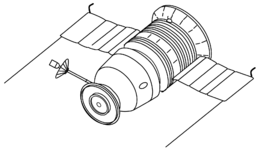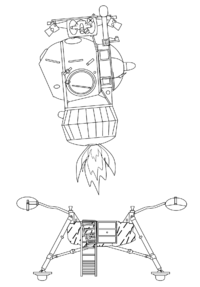Zond 4
Zond 4
 |
| Names |
Soyuz 7K-L1 s/n 6 |
|---|
|
| Mission type |
Lunar flyby
Spacecraft test |
|---|
|
| Spacecraft properties |
|---|
| Bus |
Soyuz 7K-L1 |
|---|
| Manufacturer |
OKB-1 |
|---|
| Launch mass |
5,140.00 kilograms (11,331.76 lb) |
|---|
|
| Start of mission |
|---|
| Launch date |
18:29:23, March 2, 1968 (1968-03-02T18:29:23) |
|---|
| Rocket |
Proton-K/D |
|---|
| Launch site |
Baikonur Cosmodrome |
|---|
|
| End of mission |
|---|
| Disposal |
deorbited/destroyed |
|---|
| Decay date |
March 7, 1968 (1968-03-07) |
|---|
Zond 4, part of the Soviet Zond program and an unmanned version of Soyuz 7K-L1 manned Moon-flyby spacecraft, was one of the first Soviet experiments towards manned circumlunar spaceflight. It was launched to test the spaceworthiness of the new capsule and to gather data about flights in circumterrestrial space. It was the first Soviet spacecraft to possess a computer, the 34 kg Argon 11.[1]
The spacecraft was successfully launched into a 354,000 km apogee orbit 180 degrees away from the Moon, It was launched away from the Moon probably to avoid trajectory complications with lunar gravity. However on re-entry the L1's guidance system failed. It hit the atmosphere precisely at the calculated time, but was not guided to generate lift and fly out of the atmosphere again. A ballistic re-entry would mean no recovery on Soviet soil, so the APO destruct system automatically blew up the capsule at 10 to 15 km altitude, 180–200 km off the African coast at Guinea.
References
- ↑ Huntress; Marov (2011). Soviet Robots in the Solar System: Mission Technologies and Discoveries. p. 172.
External links
|
|---|
|
Surveyor 7 | Explorer 36 | Kosmos 199 | OPS 1965 | OPS 5028 | Kosmos 200 | Apollo 5 | OPS 2243 · OPS 6236 | Kosmos 201 | E-6LS No.112 | Kosmos 202 | Kosmos 203 | OPS 7034 | Zond 4 | OGO-5 | Kosmos 204 | Kosmos 205 | Explorer 37 | DS-U1-Ya No.1 | OPS 5057 | Kosmos 206 | OPS 4849 · OPS 7076 | Kosmos 207 | Kosmos 208 | Kosmos 209 | Kosmos 210 | Apollo 6 | OV1-13 · OV1-14 | Luna 14 | Kosmos 211 | Kosmos 212 | Kosmos 213 | OPS 5165 | Kosmos 214 | Kosmos 215 | Kosmos 216 | Molniya-1 No.10 | 7K-L1 No.7L | Kosmos 217 | Kosmos 218 | Kosmos 219 | OPS 1419 | Kosmos 220 | ESRO-2B | Nimbus-B · SECOR 10 | OPS 7869 | Kosmos 221 | Kosmos 222 | Kosmos 223 | Kosmos 224 | Sfera No.12L | OPS 5138 | Kosmos 225 | Kosmos 226 | OPS 9341 · OPS 9342 · OPS 9343 · OPS 9344 · OPS 9345 · OPS 9346 · OPS 9347 · OPS 9348 | Strela-2 No.3 | Kosmos 227 | OPS 5343 · OPS 5259 | Kosmos 228 | Kosmos 229 | Explorer 38 | Kosmos 230 | Molniya-1 No.13 | Kosmos 231 | OV1-15 · OV1-16 | Kosmos 232 | Kosmos 233 | Kosmos 234 | OPS 2222 | OPS 5187 | OPS 5955 | Explorer 39 · Explorer 40 | Kosmos 235 | ATS-4 | ESSA-7 | Orbiscal 1 · OV5-8 · Gridsphere 1 · Gridsphere 2 · Gridsphere B · Gridsphere R · LCS-3 · LIDOS · SECOR 11 · SECOR 12 · Radcat · P68-1 | Kosmos 236 | Kosmos 237 | Kosmos 238 | Kosmos 239 | OPS 5247 | Kosmos 240 | Zond 5 | Kosmos 241 | OPS 0165 · OPS 8595 | Intelsat III F-1 | Kosmos 242 | Kosmos 243 | LES-6 · OV2-5 · ERS-21 · ERS-28 | Kosmos 244 | Kosmos 245 | ESRO-1A | Molniya-1 No.14 | OPS 0964 | Kosmos 246 | Kosmos 247 | Apollo 7 | Kosmos 248 | Kosmos 249 | OPS 4078 | Soyuz 2 | Soyuz 3 | Kosmos 250 | Kosmos 251 | Kosmos 252 | OPS 1315 | OPS 5296 | Pioneer 9 · ERS-31 | Zond 6 | Kosmos 253 | Proton 4 | Kosmos 254 | Kosmos 255 | STV-1 | Kosmos 256 | Kosmos 257 | OPS 6518 | HEOS-1 | OAO-2 | Kosmos 258 | OPS 4740 · OPS 7684 | Kosmos 259 | ESSA-8 | Kosmos 260 | Intelsat III F-2 | Kosmos 261 | Apollo 8 | Kosmos 262 |
|
Payloads are separated by bullets ( · ), launches by pipes ( | ). Manned flights are indicated in bold text. Uncatalogued launch failures are listed in italics. Payloads deployed from other spacecraft are denoted in brackets. |

